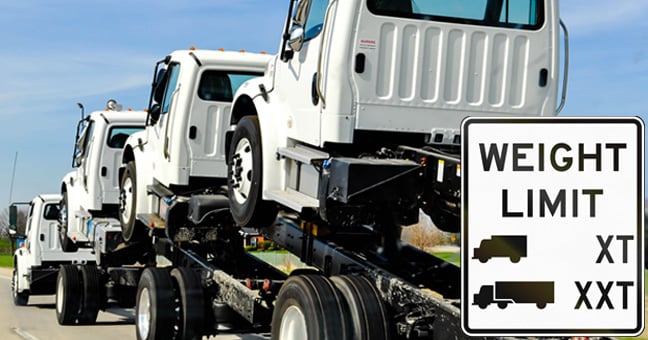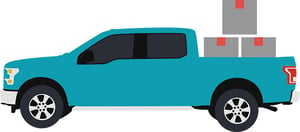

Nov 14 2023
All the different vehicle weight terminology can be quite confusing. While some are more obvious than others, the shear mass of information can be daunting. This article was written to take the weight off your chest…
All puns aside, we’ve defined the major vehicle weights that you should know – as a consumer or a business in the auto industry – as well as provided some insight into why these weights are important and whether or not they can be identified by a VIN decoding solution.

Dry weight is the total weight of a vehicle without any fluids, passengers, or cargo.
Dry weight is most important for the powersports market, however, it's not often captured by vehicle data providers for vehicles outside of the powersports market. Most businesses will want to know what vehicles weigh with the fluids and sometimes passengers/cargo.
Dry weight is not encoded in the VIN for any vehicles, however, some vehicle data providers, including DataOne, do capture dry weight in their database for the powersports market which can be tied back to the VIN/PIN.

Curb weight is the total weight of a vehicle including standard equipment and required fluids, such as motor oil, transmission oil, coolant, AC refrigerant, and in some cases, a full tank of gas. Some people refer to curb weight as wet weight.
A lighter curb weight means better fuel economy, and for the enthusiast, a quicker vehicle. This is why several vehicle manufacturers – such as Ford, Audi, Ferrari, etc. – have experimented with aluminum.
When a VIN pattern (positions 1-8,10, and 11 of the VIN) is specific to a style or trim, a base curb weight can be determined. However, optional equipment added to the vehicle can change this value by hundreds of pounds.

Gross vehicle weight (GVW) is curb weight + passengers and cargo. This can fluctuate depending on the number of passengers or amount of cargo weight. Gross vehicle weight rating (GVWR) is the maximum operating weight defined by the manufacturer and always remains the same.
From a consumer level, understanding GVWR is most important for pickup truck owners, as they tend to carry significantly more cargo than a passenger vehicle. From a commercial standpoint, transport companies need to know the GVW of their trucks, which includes the GVW of each vehicle they are transporting. There are significant fines for overloaded commercial vehicles due to the safety of not only the driver but other drivers on the road.
In order to identify GVWR by VIN number, the VIN decoding tool must also be able to identify trim by VIN. In some cases, trim will be encoded in the VIN pattern, in which case GVWR can easily be identified. However, for most cases, the full 17 digits need to be decoded which requires build data from the manufacturer.

Gross vehicle weight range, also known as vehicle classification or tonnage category, primarily pertains to trucks, as passenger vehicles will mostly sit in the first weight class, with the exception of some larger SUVs which may fall in Class 2. There are eight weight classes across three tonnage categories (light, medium and heavy-duty). Here are the weight classes:
Class 1: 0-6,000 lbs
Class 2: 6,001-10,000 lbs
Class 3: 10,001-14,000 lbs
Class 4: 14,001-16,000 lbs
Class 5: 16,001-19,500 lbs
Class 6: 19,501-26,000 lbs
Class 7: 26,001-33,000 lbs
Class 8: > 33,000 lbs
Here's a helpful infographic to better understand which vehicles fall under which weight classes:
Drivers of trucks in the heavy-duty weight class are required to have a Class B license (CDL). Insurance companies will also need to know the weight classification of each vehicle they insure. According to this Forerunner Insurance article, ”larger commercial motor vehicles require greater minimum combined insurance amounts based on the weight of the vehicle.”
GVW range can always be identified by VIN pattern.

Gross combined weight rating (GCWR) refers to the maximum combined weight of a vehicle, its fluids, passengers, and cargo, as well as the weight of the trailer it tows and the trailer’s cargo.
This is valuable information for consumers and businesses who need to spec out vehicles, predominantly trucks, for towing. GCWR will help determine which vehicle will be sufficient for towing the intended trailer and its cargo. Exceeding the GCWR can cause damage to the tow vehicle and/or the trailer, and most importantly increases the safety risk for the driver and others on the road, as mentioned earlier in the article. In fact, repeat offenses are grounds for suspension/loss of your CDL or even jail time in some states.
GCWR is not encoded directly in the VIN pattern, however, most commercial vehicle data solutions capture this information within their database which can then be accessed by VIN (sometimes requires additional data inputs) or year, make, model, trim (YMMT) search.

Max payload is the maximum amount of weight that can be added to a vehicle (passengers and cargo), in addition to the curb weight, without towing a trailer. This is often used in referring to the amount of weight in a pickup truck bed, even though passengers and any other weight added to the truck or SUV is also counted toward the max payload.
Like gross combined vehicle weight, understanding max payload is important for consumers and businesses planning to load their vehicles (mainly trucks) with a significant amount of cargo. From the business side of things, you may run a fleet for your construction business where each truck serves a different purpose. In this case, the max payload is a valuable weight to identify.
Max payload is also not encoded in the VIN pattern but captured by most commercial vehicle data solutions and accessible by VIN/YMMT search.

Base towing capacity is the OEM-recommended towing capacity based on standard equipment. For example, a truck with a V6 engine would have a certain base towing capacity, however, that same truck may have a more powerful engine optionally available which would increase the max towing capacity.
Not sure if your V6 engine will be strong enough for towing your trailer/cargo? The base towing capacity can help determine if you’ll need to upgrade your vehicle to one with a larger, more powerful engine.
Base towing capacity is not encoded directly in the VIN pattern but often an available data point within a commercial vehicle database.

The max towing capacity is the maximum weight a vehicle can tow when equipped with the optimal equipment choices. Common equipment that plays a major role in the towing capacity of a vehicle is the engine, transmission and axle ratio selections. This is only applicable for certain vehicles, such as trucks or truck-based SUVs.
Like base towing capacity, max towing capacity is important to understand for determining which truck configuration is necessary for the intended tow weight. Several businesses, including those in the fleet and transportation industries, will need to know max towing capacity.
Max towing capacity, like base towing capacity, is not encoded directly in the VIN pattern but often an available data point within a commercial vehicle database.

Gross vehicle weight rating (GVWR), also referred to as gross vehicle weight (GVW), for trailers is the maximum combined weight of a trailer and its cargo, defined by the manufacturer.
GVWR for trailers is not only important for ensuring the trailer isn’t overloaded, but also for complying with both local and federal towing laws and regulations. It’s not always easy to determine if a loaded trailer is within the manufacture’s defined GVWR without weighing it on a scale.
A more effective long-term option to avoid weighing a loaded trailer every time is to obtain the trailer’s empty weight as a starting point from the manufacturer’s specifications sheet, if available. If not available, weigh the trailer unloaded at a weighing station. Once the empty trailer weight is identified, it’ll be easy to determine how much cargo weight, or max payload, can be added to the trailer and estimate cargo weight moving forward. For businesses with a weighing station readily available, an exact weight is a better option.
Here's a helpful towing guide on RAM’s website that defines the average weights of common vehicles, trailers, RVs, construction equipment and building materials. Click the “towing info” button.
Unfortunately, GVW for trailers cannot be identified by VIN. However, this information is usually included on the trailer’s info plate or sticker.

Fuel tank capacity is an approximate estimate by the manufacturer of how much fuel a vehicle’s fuel tank can hold in gallons, or liters outside of the U.S. However, the actual fuel tank capacity can vary by as much as 3% due to “design characteristics, the manufacturing process, and other inherent factors such as the physics associated with components and electronics in the fuel system and fuel level indications,” according to the Kansas Department of Agriculture.
Not only is fuel tank capacity important for vehicle owners to know, but also helps fleets gauge how much it will cost to fill up their vehicles each time. Combined with MPG, you can get a pretty close estimate of when you will need to fill up again as well.
Like many of the others, fuel tank capacity is not encoded directly in the VIN pattern but captured by most commercial VIN decoding solutions which can then be accessed by VIN/YMMT search.
As you can see, understanding and identifying the vehicle weights above is valuable for consumers and businesses, especially in the transportation and fleet industries. If you are looking for a VIN decoding solution that can help identify some of these vehicle weights, DataOne would be happy to help. Sign up for a free trial below:
Additionally, we’d love for you to weigh in with your two cents (couldn’t pass up on this pun!) in the comments section below if there’s anything we missed, or you’d like further clarification on.